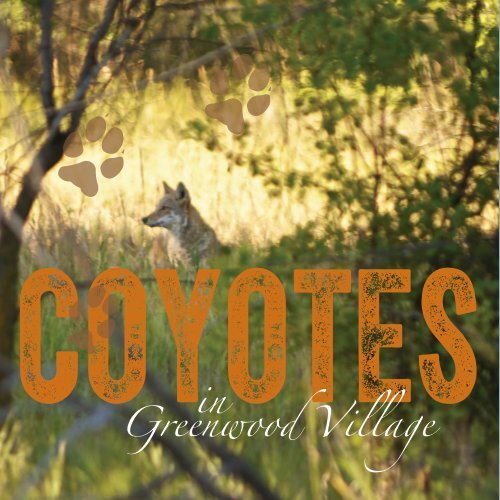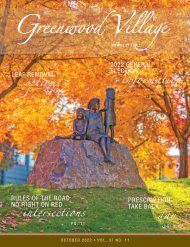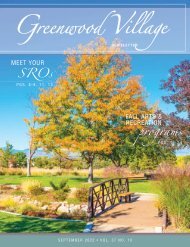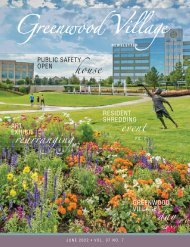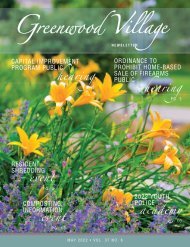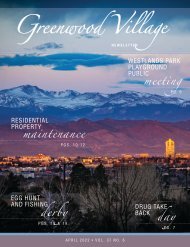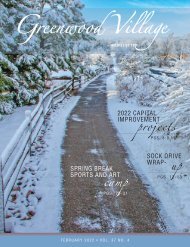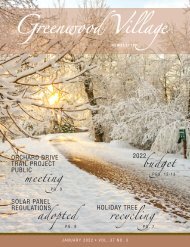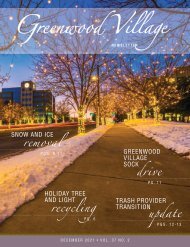CoyoteBrochPages
Create successful ePaper yourself
Turn your PDF publications into a flip-book with our unique Google optimized e-Paper software.
coyoTes<br />
in<br />
Greenwood Village
Our Village Makes a Great Home<br />
Coyote sightings are inevitable in<br />
Greenwood Village because of its<br />
abundance of open space, natural parks,<br />
running trails, and flowing drainageways<br />
that provide three essential resources<br />
coyotes need to survive: food, water, and<br />
shelter. Space is plentiful in the Village<br />
for coyotes to live. Coyotes can be active<br />
at any time of day, but are typically active<br />
at dawn, dusk, or overnight. As coyotes<br />
adapt to living in rural/urban areas like<br />
Greenwood Village, they do become<br />
accustomed to human presence. As they<br />
lose their fear of people, coyotes will<br />
become bolder in approaching people and<br />
may put themselves in situations they would<br />
normally avoid.
The Coyote’s Biography<br />
Family Ties<br />
The coyote is a medium-sized member of the dog family<br />
that includes wolves and foxes. With pointed ears, a<br />
slender muzzle, and a drooping bushy tail, the coyote often<br />
resembles a small German Shepherd or Husky. Coyotes are<br />
usually grayish brown with reddish tinges behind the ears<br />
and around the face, but coloration can vary from a silvergray<br />
to black. The tail usually has a black tip. Eyes are<br />
yellow, rather than brown like many domestic dogs. Most<br />
adults weigh between 25 to 35 pounds.<br />
Expanding Their Family<br />
Generally, you may see and hear coyotes more during mating season<br />
(December through February) and when juveniles are dispersing from<br />
their family group (September through November). Coyote pups are<br />
born April through May, and are taught to hunt at approximately<br />
12 weeks of age, at which time they no longer utilize their den. The<br />
litter size is determined by the local coyote population density and<br />
food availability. The pups disperse from the family at approximately<br />
20 weeks of age which will often result in more coyote sightings.<br />
The average weight of a coyote in the<br />
Village is 29 pounds.<br />
Café Coyote<br />
A plentiful food source exists in the Village on which<br />
coyotes prey. Up to 70 percent of a coyote’s diet consists<br />
of small animals like mice, rabbits, rats, squirrels, and<br />
voles. The remaining 30 percent is a combination of fruits,<br />
vegetables, insects, fish, birds, and eggs. Occasionally,<br />
coyotes have been known to prey on small pets as a food<br />
source.<br />
In your neighborhood, coyotes are attracted to an array of<br />
items which are commonly found and easily accessible:<br />
• Outdoor pet food and water<br />
• Birdseed<br />
• Garbage or compost<br />
• Fallen fruit or berries from trees or shrubs<br />
Coyote Life Cycle<br />
December–January–February<br />
February–March–April<br />
April–May<br />
May–June–July<br />
July–August–September–October<br />
October–November–December<br />
Breeding Activity<br />
Den Site Selection<br />
Birthing<br />
Raising Pups<br />
Expanding Home Range<br />
Dispersal of Pups
Their Den<br />
In April, after a 62- to 65-day gestation period, the female<br />
will begin looking for existing dens or dig one herself.<br />
Pup season is the time coyotes will voluntarily use a den;<br />
otherwise, coyotes usually sleep above ground in the<br />
open or in cover. Dens may consist of an existing burrow<br />
made by skunks or other medium-sized wildlife. Coyotes<br />
will also build dens from scratch by digging a hole and<br />
sometimes will use wooden decks or patios. They usually<br />
prefer some protective cover of the den, such as bushes<br />
or trees, and some type of slope for drainage. It is not<br />
uncommon for mothers to move their young from den to<br />
den to keep them protected or to re-use the same den<br />
over multiple years. Coyotes keep watch near their dens<br />
to keep threats away from their young.<br />
Coyotes are more active hunters in the<br />
months of May through November.<br />
At night, coyotes both howl a high,<br />
quavering cry and emit a series of<br />
short, high-pitched yips. Howls are<br />
used to keep in touch with other<br />
coyotes in the area and not a sign of<br />
imminent danger.<br />
Hard Habits to Break<br />
Coyotes are predictable with their behaviors in most<br />
habitats, whether it’s in a rural or urban environment.<br />
• Coyotes can be seen throughout the day, but are<br />
especially active at dawn and dusk.<br />
• Coyotes are curious and are known to stare at humans.<br />
They sometimes follow humans out of natural curiosity<br />
or to keep them away from their pups.<br />
• They communicate by vocalizing and scent marking.<br />
• Coyotes are fast and agile; they can run at speeds<br />
of 25-40 m.p.h. and will jump as high as eight feet or<br />
equivalent to the height of a residential privacy fence.<br />
• They are highly intelligent and social animals; they<br />
learn quickly and are devoted parents to their young.<br />
• Coyotes are solitary creatures and mark their territory<br />
with urine. During the winter, coyotes tend to become<br />
more social and they join forces, creating hunting<br />
packs to find food more easily.<br />
• Coyotes may live in family packs or on their own at<br />
different points in their lives.<br />
• Coyotes have a mate for life and are monogamous until<br />
the mate dies.
The Potential Conflict<br />
Wildlife experts indicate that most coyote and human<br />
conflicts have been a direct result of human behavior<br />
such as feeding coyotes, walking a dog without a leash,<br />
or leaving food or water outside for your pets. Although<br />
these behaviors may seem innocent, they are actually<br />
harmful to you and your family, and to the health and<br />
safety of the coyote population.<br />
June through November are the<br />
months of the year where we see the<br />
most conflict between urban coyotes<br />
and humans and pets.<br />
Here are some tips to help you avoid conflicts with<br />
coyotes in your neighborhood:<br />
Your Home<br />
• Never feed coyotes! Intentionally feeding coyotes is<br />
illegal and this law will be enforced.<br />
• Remove attractants from your yard such as pet food,<br />
water sources, bird feeders and fallen fruit.<br />
• Secure trash in a container with a locking lid.<br />
• Trim up vegetation to reduce hiding places.<br />
Keeping Coyotes Out - Most fences and garden walls<br />
will not deter coyotes from entering onto your property.<br />
A good rule of thumb is that anything a cat can get<br />
through or over, a coyote can, too.<br />
Pet Doors - Do not leave pet doors open, especially when<br />
you are not home, even in the middle of the day. If you<br />
have a cat or dog door in your home, make sure it is shut<br />
especially at dawn, dusk, and at night.<br />
Pets Away from Yard - Be cautious when bringing pets<br />
back home after they have been away from yard due<br />
to vacation or for other events. Coyotes usually move<br />
into the area when family pets leave and pet-coyote<br />
interactions occur when the dog returns home.<br />
Your Pet<br />
• Keep pets on a 6-foot leash or shorter when walking.<br />
• Never allow your pets to “play” with a coyote.<br />
• Pick up small pets if confronted by a coyote.<br />
• Any size pets, large or small, could be targets if<br />
coyotes feel threatened.<br />
• Always supervise your pet when outside, especially at<br />
dawn and dusk.<br />
• Never leave cats or dogs outside unattended.<br />
• Never allow dog bones to be left in your yard.<br />
• Spay or neuter your dogs as coyotes are particularly<br />
attracted to female dogs in estrous.<br />
Coyotes may perceive other animals,<br />
including pets, as a threat or competition<br />
to their territorial domain. Studies have<br />
shown that coyotes generally do not rely<br />
on pets for their diets.
The Encounter<br />
Hazing<br />
Spring is denning season for coyotes with new pups in the<br />
dens, and it is likely a Village resident will have some type of<br />
encounter with a coyote during this time. The most effective<br />
method people can use is hazing when encountering a<br />
coyote as a means to move the coyote out of the area or<br />
discourage an undesirable behavior or activity. Hazing<br />
can help maintain a coyote’s fear of humans and deter<br />
them from neighborhood spaces such as backyards and<br />
playgrounds.<br />
How Does Hazing Work?<br />
Using a variety of different hazing tools is critical<br />
because coyotes can habituate to individual items,<br />
sounds, and actions. A coyote who is being hazed must<br />
be able to recognize the potential threat is coming from<br />
a person. Therefore, hiding behind a bush and throwing<br />
rocks or hazing from inside your car isn’t effective. You<br />
can use hazing techniques and tools for one animal or<br />
multiple animals. There is usually a dominant animal<br />
in the group who will respond, and others will follow<br />
its lead. Don’t stop hazing after your hazing method is<br />
successful. Be persistent in your hazing efforts. Coyotes<br />
or their pups could return to their unacceptable habits<br />
or behaviors if hazing efforts are not continued. Once<br />
you haze the coyote, it may return. Continue to haze the<br />
coyote as you did before; it usually only takes a couple of<br />
times for the coyote to not return.<br />
Haze. Haze. Haze. Continue hazing the<br />
coyote at every opportunity even if<br />
the coyote doesn’t seem aggressive.<br />
Coyotes that have been effectively<br />
hazed are much more likely to develop<br />
a fear of humans and move along to a<br />
new habitat.<br />
Recommended Methods of Hazing<br />
• Yell and wave your arms while approaching the<br />
coyote – “Go Away Coyote”<br />
Stand your ground and face the coyote. If a coyote<br />
approaches you, be as big, mean, and loud as possible.<br />
Wave your arms and throw objects at the coyote.<br />
Shout in a deep, loud, and authoritative voice. Do not<br />
run or turn your back on the coyote. If attacked, fight<br />
back with your fists and feet.<br />
• Use Noisemakers<br />
Make yourself loud by using tools such as whistles, air<br />
horns, bells, soda cans filled with pennies, or pots and<br />
pans to scare the coyote with sound.<br />
• Use Projectiles<br />
Show your authoritative presence by exhibiting power<br />
with walking sticks, small rocks, cans, tennis, or rubber<br />
balls.<br />
• Try Other Repellents<br />
Hoses, water guns or spray bottles with vinegar water,<br />
pepper spray, or bear repellent are effective methods<br />
to scare the coyote. Citronella Spray (Brand: Spray<br />
Shield) is also very effective for hazing a coyote. If a<br />
coyote is in your yard and will not leave, you can use<br />
ammonia rags (ammonia soaked rags, with 70 percent<br />
ammonia to 30 percent water). Place ammonia rags<br />
in areas where coyotes have frequently been seen on<br />
your property. During warmer months you can squirt<br />
them with a hard spray from your water hose.
Don’t Haze When…<br />
• The coyote is sick or injured. Call Animal Control of the Police Department<br />
at 303-773-2525 for assistance.<br />
• You think you could be near a coyote den or pups could be present<br />
(usually between March and July). You may encounter a coyote who is trying<br />
to scare you away from its den by acting assertive. Slowly remove yourself from<br />
the area and call the Police Department immediately.<br />
Greenwood Village Coyote Management Plan<br />
In an effort to ensure the safety of the community and foster human-coyote coexistence<br />
in the Village, the Police Department has a comprehensive Coyote Management Plan<br />
to handle public safety concerns and to address coyote activities and behaviors in<br />
Greenwood Village. The Plan is four-pronged, consisting of public education on how to safely coexist<br />
with coyotes and how to avoid human-coyote conflicts; enforcement of laws that prohibit the feeding of wildlife and require<br />
domestic animals to be leashed; active “hazing” of coyotes to instill or re-instill a healthy fear of humans; and lethal control<br />
measures to eliminate dangerous or menacing coyotes.<br />
Village Response to Coyote Sightings, Encounters, Incidents and Attacks<br />
INCOMING CALL<br />
Sighting Encounter Incident Attack<br />
Normal Coyote Log Entry<br />
Habituated Nuisance<br />
Unprovoked<br />
Habituated Depredating<br />
Menacing Nuisance<br />
Provoked/Unprovoked<br />
Dangerous<br />
Incident Report/Hazing<br />
EDUCATION ENFORCEMENT<br />
Incident Report/Hazing<br />
EDUCATION ENFORCEMENT<br />
Incident Report/Hazing<br />
EDUCATION ENFORCEMENT<br />
Hazing Decision Hazing Decision Hazing Decision<br />
Command Staff Evaluation<br />
Lethal Control<br />
Command Staff Evaluation<br />
Lethal Control<br />
Command Staff Evaluation<br />
Lethal Control<br />
Sighting = Visual observation of a coyote.<br />
Encounter = An unexpected direct meeting between humans and coyotes that is without incident.<br />
Incident = An unsafe condition where a coyote displayed abnormal behavior.<br />
Attack = An aggressive action initiated by the coyote that involves physical contact with a human.
Coyote Laws in Colorado<br />
• There are no federal restrictions over management<br />
and control of coyotes. The rules and regulations<br />
are governed by the state.<br />
• Per the Colorado Parks and Wildlife, relocation of<br />
coyotes is not an option.<br />
• Amendment 14 of the Colorado State Constitution<br />
prohibits the use of leg-hold trapping in the<br />
state except in certain circumstances. Colorado<br />
Department of Public Health and Environment is<br />
authorized to issue exemptions to use prohibited<br />
devices to capture aggressive coyotes. There has<br />
to be documentation of the existence of aggressive<br />
behavior before a permit may be issued.<br />
C.R.S. 33-6-107(9) Allows you to manage coyotes<br />
that are causing damage to your property. This<br />
management may only be performed on your<br />
property.<br />
C.R.S. 33-6-128 Damage or destruction of dens on<br />
public lands is prohibited. Unless permitted by the<br />
Division (of Wildlife), it is unlawful for any person to<br />
willfully damage or destroy any wildlife den.<br />
C.R.S. 33-6-130 Explosives, toxicants, and poisons not<br />
to be used states: “unless permitted by law or by the<br />
Division of Wildlife, it is unlawful for any person to<br />
use toxicants, poisons, drugs, dynamite, explosives,<br />
or any stupefying substances for the purpose of<br />
hunting, taking or harassing any wildlife.”<br />
Report Any Coyote Activity<br />
Always haze a coyote even if it seems<br />
non-confrontational, and then call the<br />
Police Department at 303-773-2525 to<br />
report any sightings or interactions<br />
with coyotes. The Police Department<br />
actively keeps a record of coyote<br />
activity in the Village to assist in<br />
tracking the coyote population.<br />
Call 9-1-1 immediately to report<br />
aggressive coyotes.<br />
Greenwood Village Animal Control<br />
www.greenwoodvillage.com<br />
Greenwood Village Police Department Animal Control<br />
6060 South Quebec Street<br />
Greenwood Village, CO 80111<br />
303-773-2525<br />
animalcontrol@greenwoodvillage.com


